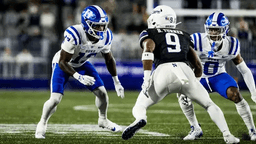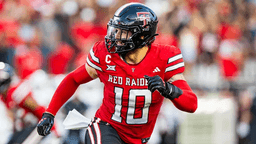Gone Fishing: MLB teams reel in fresh talent from the Carolinas in Draft
MLB’s 2024 Draft saw 68 players taken that had played in either North or South Carolina.
By: Emmet Mahon · Draft Carolina · 1y

Photo: Yahoo Sports
Over the course of three days, Major League Baseball organizations conducted its annual draft. Between the Cleveland Guardians selecting Oregon State 2B Travis Bazzana and the Texas Rangers selecting McLennan Community College C Mac Rose, 615 players were drafted, and 615 dreams of major league stardom were launched. Players from 45 states were drafted. North Carolina had the third most players taken with 46, finishing behind California (67) and Texas (65). South Carolina was in the middle of the pack of prospect producing states with 22.
A review of draft databases reveals interesting and informative statistical tidbits. The first player drafted out of a Carolina based team was flame throwing RHP Chase Burns from Wake Forest who went second overall to the Cincinnati Reds. When teammates Nick Kurtz was drafted by the Oakland Athletics and Seaver King by the Washington Nationals, Wake Forest became the first college to produce a three first round picks since 2015 when the Vanderbilt trio of Dansby Swanson, Carson Fulmer, and Walker Buehler, matched the 2004 Rice Owls in accomplishing that feat.
Over the course of the first round, which was comprised of regular picks, Prospect Promotion picks, Free Agent Compensatory picks, and Competitive Balance A picks, Carolina trained players produced six of the 39 selections in those rounds. Of the top 200 rated drafted prospects according to Baseball America, 17 were from Carolina teams. In the important first 10 rounds, the Carolinas had 39 players drafted. Players selected in those rounds must sign with the teams that drafted them or their slot bonus amount is deducted from that teams total pool. Since the slotting system was implemented in 2012, only 46 players taken in the first 10 rounds failed to sign. Of those 46, 28 failed signings occurred between 2012 and 2015. The probability of Carolina based prospects from the first 10 rounds of this draft becoming professionals is high.
There has been a shift in recent years in the drafting of prep prospects. Due to increased collegiate scholarships, the introduction of NIL, and the fear of losing bonus pool money, high school players enjoy unprecedented leverage, but infrequent selection. Not long ago, prep players were drafted in close ratio to college players. That has not been the case recently, in the draft in general and with Carolina based prep arms. Seven prep trained players from North and South Carolina were drafted this year compared to 61 collegiate trained players. Interestingly, four South Carolina players were selected from two programs. Summerville High School and P27 Academy in Lexington both had two players drafted.
A significant factor in the Carolinas producing so many college prospects is the large number of successful programs populating the region. Players from 16 North Carolina schools had players drafted, while South Carolina chipped in with players from nine programs. These programs ran the gambit from national powers such as North Carolina, Duke, and Clemson, down to tiny Queens University of Charlotte and University of South Carolina-Upstate. Wake Forest, East Carolina, and North Carolina, tied for the most draftees from any program with six. Those schools tied for 12th in total number of players drafted. Not surprisingly, Clemson lead the way among South Carolina programs with five players selected. Mississippi State was the school most often tapped this year with 11 players taken.
Now that the scouting and drafting is complete, the process of signing players and getting them to either the Arizona Complex League or Florida Complex League begins. Burns has already agreed to a $9.25 million bonus with the Reds. Other signing announcements are starting to trickle out. Teams have until August 1st to sign their picks. Any high school player that does not agree to a contract cannot be drafted again 2027, unless they matriculate to a junior college, then they would be eligible to be drafted again next year. College juniors and redshirt sophomores have a little negotiating leverage over teams with the ability to return to school and being eligible next year. The risk being that an injury or being bypassed on the depth chart could negatively impact their draft stock. Seniors have the least leverage and often agree to four or five figure bonuses. College seniors are popular in the lower half of the top 10 rounds because their low bonuses can be redeployed to higher leverage prospects requiring over-slot bonuses.
Even though a fan’s favorite player is leaving their favorite Carolina school does not mean that player won’t be hard to follow. It is industry practice for new draftees to not get little or no playing time in their draft year. They will participate in the organization’s Instructional League in the fall. Spring training will be a prospect’s first immergence in professional baseball. Once camp breaks, most of these prospects will fill out the rosters of the many Low A Carolina League franchises in the region. A handful of advanced prospects, usually players drafted out of top college programs, will begin their careers in High A South Atlantic League.
Carolina sports fans were stung recently by the lack of regional players being selected in the NBA Draft. The MLB Draft proves that Carolina baseball is alive and thriving. Between high school, college, and the minor leagues, baseball fans in the Carolinas will have little difficulty in scratching their hardball itch. As players get drafted and move on, new, fresh faces emerge to take their place and the cycle continues. Major League Baseball expansion might one day place a team in the Carolinas, adding to the excitement and anticipation to the draft. The MLB Draft will never be as big as the NFL Draft, but the Carolinas produce enough talent to keep it on fans’ radar year round.





Comments:
Log in or sign up to read and post comments.